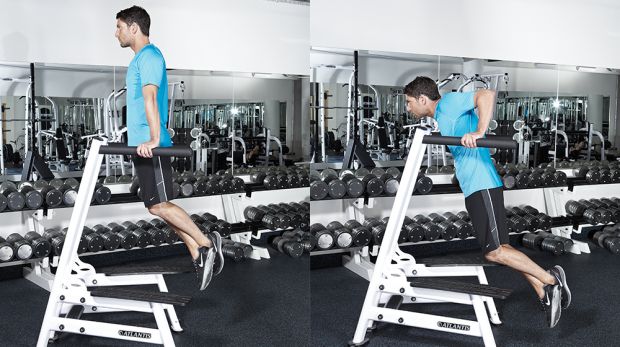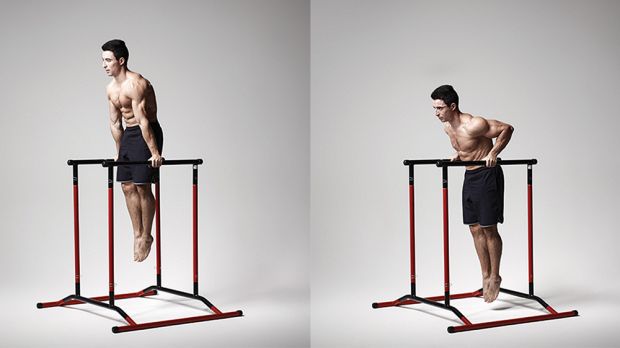How To Do Triceps Dips
Dips are a great compound bodyweight exercise that adds real mass to your triceps

Generally, health and fitness is about taking the holistic approach of staying active and eating well in order to live a long and happy life. But sometimes it isn’t. Sometimes it’s just about one thing: building massive, sleeve-splitting upper arms. And for that, you need the best triceps exercises – you need the triceps dip in your life.
That’s because while people tend to focus on their biceps, the triceps are actually a bigger muscle group than their glamorous, front-of-arm counterparts. So if you’re chasing size, neglecting the back of your arms is pure folly.
The triceps are made up of three heads, hence their name, and if you want to increase the strength and size of your upper arms you need to work all three. Fortunately, you can do just that with one exercise – the triceps dip.
Read on for everything you need to know about this fundamental bodyweight exercise, including a range of variations you can use to increase the difficulty involved once you’ve mastered the standard dip.
How To Do Triceps Dips

Wherever and however you dip, the key is arm position. Your hands should be shoulder-width apart on the surface you are dipping from, with your arms straight. Squeeze your core and glutes then raise your chin and chest to keep your body tight. From there, start the move by bending your elbows. Dip down until your arms are at a 90-degree angle.
Pause at the bottom for a one or two count, then press back up powerfully, ensuring you keep your core and glutes tight to prevent your legs swinging. Don’t fully lock out your arms at the top; keeping a slight bend in your elbows at the top forces your triceps to work far harder.
To expose your triceps to as much time under tension as possible – a key stimulus for adding new muscle tissue – lower your body as slowly as you can. Aim for two seconds at first, building up over time to four seconds. Get as low as you can without stressing your shoulders.
Sign up for workout ideas, training advice, reviews of the latest gear and more.
Three sets of eight to ten dips, perhaps pushing the third set until you physically can dip no more, should leave your upper arms in tatters for a day or two.
At the gym you can do dips that support your whole body on parallel bars, but you can also use a bench or chair to dip anywhere with your feet on the floor. Just make sure whatever surface is involved can take your body weight, and it’s probably wise not to opt for a chair on wheels…
Triceps Dips Form Tips

“The dip is one of the best exercises for building triceps size and strength for a number of important reasons,” says Viktor Genov (pictured), a personal trainer at Fitness First Tottenham Court Road. “First, they allow for a great range of motion, which is critical to working a muscle fully. As a compound lift that causes shoulder extension and elbow extension, the dip also recruits more muscle fibres, and the movement pattern allows a big stretch at the bottom position as well as a big contraction at the top.”
If you can’t do a full bodyweight dip, Genov advises starting with a band-assisted variation. “This will enable you to master the movement pattern and begin to build the strength needed to do the full move,” he says. “You can also make it easier by leaning your chest forwards and bringing your knees closer to your chest.”
Grip
Parallel bars are the best option for dips. “For the ideal hand placement the bars should be no wider than the length of your forearm,” says Genov. “If your hands are any wider apart then you will shift tension away from your triceps and towards your shoulders, so you risk placing too much stress on your shoulder joints.”
Abs
As with press-ups, it’s essential your abs are fully engaged from the moment before you start the set to the moment after it’s finished. “Bracing your abs effectively is so important to getting better at bodyweight moves,” says Genov. “You can improve your ability to engage your abs by doing more planks. If you want to master bodyweight exercises, planks will become your best friend.”
Shoulders
“Your shoulders must work very hard in the dip because they need to be fixed in position the whole time, pushed forwards and downwards,” says Genov. “Keep your head as far back as you can with your chin up, not pressed down towards your chest, and tense your neck muscles to keep your head still. Lower yourself until your shoulders are level with your elbows – don’t go any lower than this because it risks straining your shoulder joint and removes tension from the triceps.”
Elbows
“Keep your elbows tucked in to your torso as much as possible and don’t ever let them flare out to the sides,” Genov says. “By doing this you will place and keep more tension on the triceps and reduce the potential stress on your elbow and shoulder joints.”
Toes
“Pointing the toes straight down ensures complete tension throughout the entire body,” says Genov. “Most people always try to make a bodyweight move easier, but that makes it less effective. By making it harder and placing the maximum tension on the target muscle – in this case, the triceps – you are making these muscles work harder and that’s what gets the best results.”
Targets
- Beginner Up to 5 band-assisted reps at a 2131 tempo
- Intermediate Up to 5 reps at a 2131 tempo
- Advanced 10+ reps at a 1121 tempo
- Viktor Genov’s PB 15
Triceps Dips Variations
From beginner to expert, dips are versatile enough to include in anyone’s workout. One way to tweak the move is to lean forwards to increase the involvement of the pecs, instead of holding your torso upright which keeps the focus on the triceps.
To keep mixing things up, master each of these variations before moving on to the next.

1. Bench dip with knees bent
How Place your hands on a bench or box behind you with your feet together and flat on the floor with knees bent. Lower slowly as far as you can, then press back up powerfully.
Why This is a beginner-friendly move because the amount of your own bodyweight that you have to lift is reduced by the position of your legs.
2. Bench dip with legs straight
How Place your hands on a bench or box behind you with your feet together, legs straight and heels on the floor. Lower slowly as far as you can, then press back up powerfully.
Why While still a beginner-friendly move, this variation is slightly tougher because you have to lift and lower a higher proportion of your own bodyweight.
3. Bench dip with legs raised
How Place your hands on a bench or box behind you with your feet together on a slightly lower bench or box with knees bent. Lower slowly as far as you can, then press back up powerfully.
Why Having your feet elevated increases the amount of bodyweight you have to lift and lower, making this a more challenging variation.
4. Parallel bars dip
How Grasp parallel bars using an overhand grip and raise your body until your arms are straight. Keeping your chest up and your core engaged, lower slowly as far as you can, then press back up powerfully.
Why This is the classic triceps dip and mastering it will help you add size and strength to the backs of your upper arms. Always warm up your triceps as well as your elbow and shoulder joints before doing this move.
5. Parallel bars dip with weights
How Attach weights to a weight belt and grasp parallel bars using an overhand grip, then raise your body until your arms are straight. Keeping your chest up and your core engaged, lower slowly as far as you can then press back up powerfully.
Why Once you can comfortably manage three sets of ten parallel bars dips, sticking to a slow and controlled tempo, you may want to consider adding extra resistance to your reps in the form of a weight plate. This will challenge your muscles far more, but start out with a small plate – 2.5kg to 5kg – and build up the extra resistance slowly so your muscles and joints have time to adjust.
More Triceps Dips Variations
Band-assisted dip
If you’re using bars or a dipping station you can use a resistance band to make the move easier, as you can with pull-ups. Loop a long band between the bars and rest your knees on it. Lower as normal, then enjoy some assistance from the band as you push back up.
As you get more confident with the move you can sub in lighter bands, gradually reducing the assistance until you need no bands at all to perform a dip. Keep hold of those bands, though, because you can loop them over your shoulders to create resistance, making the exercise harder.
Dip with leg raise
Adding a core cruncher like a hanging leg raise at the end of your dip varies the benefits of the move, as well as making it a whole lot harder. Dip from a station or bars as normal, then push back up until your arms lock out. Hold your torso still as you lift your legs until they are extended in front of you, parallel to the ground. Hold the position for a second, then lower your legs slowly back to the start and go straight into your next dip.

Sam Rider is an experienced freelance journalist, specialising in health, fitness and wellness. For over a decade he's reported on Olympic Games, CrossFit Games and World Cups, and quizzed luminaries of elite sport, nutrition and strength and conditioning. Sam is also a REPS level 3 qualified personal trainer, online coach and founder of Your Daily Fix. Sam is also Coach’s designated reviewer of massage guns and fitness mirrors.
- Joe WarnerFormer editor of Men’s Fitness UK
